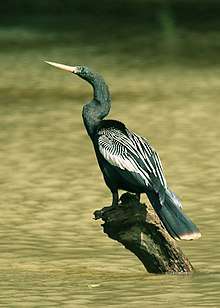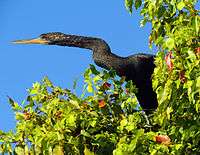Anhinga
The anhinga (/ænˈhɪŋɡə/; Anhinga anhinga), sometimes called snakebird, darter, American darter, or water turkey, is a water bird of the warmer parts of the Americas. The word anhinga comes from the Brazilian Tupi language and means devil bird or snake bird. The origin of the name snakebird is apparent when swimming: only the neck appears above water so the bird looks like a snake ready to strike. They do not have external nares (nostrils) and breathe solely through their epiglottis.
| Anhinga | |
|---|---|
 | |
| Male in Costa Rica | |
| Scientific classification | |
| Kingdom: | Animalia |
| Phylum: | Chordata |
| Class: | Aves |
| Order: | Suliformes |
| Family: | Anhingidae |
| Genus: | Anhinga |
| Species: | A. anhinga |
| Binomial name | |
| Anhinga anhinga (Linnaeus, 1766) | |
| Subspecies | |
|
A. a. anhinga | |
 | |
| Range of A. anhinga Breeding range Resident range | |
| Synonyms | |
|
Plotus anhinga Linnaeus, 1766 | |
The anhinga is placed in the darter family, Anhingidae, and is closely related to Indian (Anhinga melanogaster), African (Anhinga rufa), and Australian (Anhinga novaehollandiae) darters. Like other darters, the anhinga hunts by spearing fish and other small prey using its sharp, slender beak.
Distribution and migration
Anhinga species are found all over the world in warm shallow waters.[2] The American anhinga has been subdivided into two subspecies, A. a. anhinga and A. a. leucogaster, based on their location. A. a. anhinga can be found mainly east of the Andes in South America and also the islands of Trinidad and Tobago. A. a. leucogaster can be found in the southern United States, Mexico, Cuba, and Grenada.[3] A fossil species Anhinga walterbolesi has been described from the Late Oligocene to Early Miocene of Australia.
Only birds that live in the extreme north and south of their range migrate and do so based on temperature and available sunlight. Anhingas will migrate towards the equator during winter but this range is "determined by the amount of sunshine to warm the chilled birds".[2] Although not in their usual range, anhingas have been found as far north as the states of Pennsylvania[4] and Wisconsin[5] in the United States.
Kettles of anhingas often migrate with other birds and have been described as resembling black paper gliders.[6]
Description
The A. anhinga species is a large bird and measures approximately 89 cm (35 in) in length, with a range of 75–95 cm (30–37 in), and a 1.14 m (3.7 ft) wingspan.[7][8] The A. a. anhinga subspecies is larger than A. a. leucogaster and has "broader buffy tail lips".[3] They weigh on average around 1.22 kg (2.7 lb), with a range of 1.04–1.35 kg (2.3–3.0 lb).[8][9][10] The bill is relatively long[5] (about twice the length of the head[11]), sharply pointed[7] and yellow like their webbed[9] feet.
The male is a glossy black-green with the wings, base of wings, and tail a glossy black-blue.[11] The tip of the tail has white feathers.[12] The back of the head and the neck have elongated feathers that have been described as gray[13] or light purple-white.[11] The upper back of the body and wings is spotted or streaked with white.[13]
The female anhinga is similar to the male except that it has a pale gray-buff[14] or light brown[15] head, neck, and upper chest. The lower chest or breast is a chestnut color and as compared to the male, the female has a more brown back.[16]
The hatchling starts out bald but gains tan down within a few days of hatching. Within two weeks the tan down is replaced by white down. Three weeks after hatching, the first juvenile feathers appear. Juveniles are mostly brown until they first breed usually after the second or third winter.[2]
This bird is often mistaken for the double-crested cormorant due to its similar size and shape, although the two species can be differentiated by their tails and bills. The tail of the anhinga is wider and much longer than that of the cormorant. The bill of the anhinga is pointed, while the bill of the cormorant has a hook-tip.[17]
Behavior
Anhingas swim with their webbed feet and pursue their prey, fish, under water and spear their prey by rapidly stretching out their neck. They come up to handle and swallow fish.[18] Unlike ducks, ospreys and pelicans which coat their feathers with oil from their uropygial gland, the anhinga does not have waterproof feathers. Their feathers get soaked upon immersion in water. Therefore, they cannot stay floating on water for long periods of time. Their dense bones, wetted plumage and neutral buoyancy in water, allows them to fully submerge and search for underwater prey.[19]
The anhinga cannot fly with wet feathers. If it attempts to fly while its wings are wet, the anhinga has difficulty, flapping vigorously while "running" on the water. Like cormorants, the anhinga stands with wings spread and feathers fanned open in a semicircular shape to dry its feathers and absorb heat. They face away from the sun to dry their feathers.[20] Anhingas lose body heat relatively fast and their posture helps them absorb solar radiation from the sun to balance the high rates of heat loss.[20] Because an anhinga in the drying position resembles a male turkey, it has been referred to colloquially as the water turkey or swamp turkey.
Diet
Anhingas feed on moderately sized wetland fishes. [8] In Alabama, the anhinga's diet consists of fishes such as Mullet (fish), sunfish, catfish, suckers (Catostomidae), Chain pickerel, crayfish, crabs, shrimp, aquatic insects, tadpoles, water snakes (Nerodia) and small terrapins.[21] In Florida, sunfishes and bass (Centrarchidae), killifishes (Cyprinodontiformes) and live-bearing fishes (Poeciliidae) are primarily eaten by the anhingas.[22]
Anhingas stalk fish underwater, mainly where there is some flora present. Once they locate their prey, they partly open their bill and stab the fish swiftly. For larger fish, they use both their jaws and use the lower jaw on small fish.[8] If the fish is too large to forage, the anhinga stabs it repeatedly and then lets it go.[23] The anhingas bring their capture to the surface of the water, toss it backwards and engulf it head-first. [22]
Conservation status
The anhinga is protected in the US under the Migratory Bird Treaty Act of 1918.[24] The number of individual anhingas has not been estimated but they are considered to be of least concern because of the frequency of their occurrence in their 15,000,000 km2 (5,800,000 sq mi) global range.[1]
 Male drying its feathers and warming its body, Florida, US
Male drying its feathers and warming its body, Florida, US Showing snake-like neck and pointed beak
Showing snake-like neck and pointed beak In flight, South Carolina, US
In flight, South Carolina, US Juvenile in Uarini, Amazonas, Brazil
Juvenile in Uarini, Amazonas, Brazil.jpg) Juveniles with white plumage
Juveniles with white plumage Female in Florida, US
Female in Florida, US
References
- BirdLife International (2012). "Anhinga anhinga". IUCN Red List of Threatened Species. 2012. Retrieved 26 November 2013.CS1 maint: ref=harv (link)
- Nellis, David W. (2001). Common Coastal Birds of Florida and the Caribbean. Pineapple Press, Inc. p. 110. ISBN 978-1-56164-191-8.
- Blake, Emmet Reid (1953). Birds of Mexico: a guide for field identification. University of Chicago Press. pp. 151–152. ISBN 0-226-05641-4.
- McWilliams, Gerald M.; Brauning, Daniel W. (1999). Birds of Pennsylvania. Cornell University Press. p. 43. ISBN 978-0-8014-3643-7.
- Robbins, Samuel D. (1991). Wisconsin Birdlife: Population and Distribution Past and Present. University of Wisconsin Press. pp. 127–128. ISBN 978-0-299-10260-9.
- Eubanks, Ted L.; Behrstock, Robert A.; Weeks, Ron J. (2006). Birdlife of Houston, Galveston, and the Upper Texas Coast. Texas A&M University Press. p. 70. ISBN 978-1-58544-510-3.
- Sibley, David Allen (2003). The Sibley Field Guide to Birds of Eastern North America. New York: Alfred A. Knopf. p. 45. ISBN 0-679-45120-X.
- "Anhinga". All About Birds. Cornell Lab of Ornithology.
- Maehr, David S.; Kale, H.W.; Kale, II, Herbert W. (2005). Florida's Birds: A Field Guide and Reference. Pineapple Press Inc. pp. 33, 38. ISBN 1-56164-335-1.
- Hennemann, III, Willard W. (December 1985). "Energetics, Behavior and the Zoogeography of Anhingas and Double-Crested Cormorants". Ornis Scandinavica. Wiley. 16 (4): 319–323. JSTOR 3676697.
- Audubon, John James (1843). The Birds of America. J.B. Chevalier. pp. 443–457.
- Wood, Tom; Williamson, Sheri L.; Glassberg, Jeffrey (2005). Birds of North America. Sterling Publishing Company, Inc. p. 50. ISBN 1-4027-2821-2.
- Chapman, Frank M. Handbook of Birds of Eastern North America (PDF). Harvard University. p. 93. doi:10.5962/bhl.title.34046.
- Burton, Maurice; Burton, Robert (2002). International Wildlife Encyclopedia. Marshall Cavendish. pp. 646. ISBN 0-7614-7271-1.
- Gregware, Bill; Gregware, Carol (1997). Guide to the Lake Okeechobee Area. Pineapple Press Inc. p. 54. ISBN 1-56164-129-4.
- Fjeldså, Jon; Krabbe, Niels; Jørgensen, Povl; Byskov, Jens Ole (1990). Birds of the High Andes. Apollo Books. p. 74. ISBN 87-88757-16-1.
- Peterson, Roger Tory (1998). A Field Guide to the Birds of Texas. Houghton Mifflin Harcourt. p. 130. ISBN 0-395-92138-4.
- Frederick, P. C. and D. Siegel-Causey (2000). Anhinga (Anhinga anhinga), version 2.0. In The Birds of North America (A. F. Poole and F. B. Gill, Editors). Cornell Lab of Ornithology, Ithaca, NY, USA. Pg 4-5 DOI: 10.2173/bna.522
- "Anhinga - Introduction". Birds of North America Online. Archived from the original on 2018-06-05. Retrieved 2018-12-08 – via website: birdsna.org.
- Hennemann, Willard W. "Energetics and Spread-Winged Behavior of Anhingas in Florida" The Condor84, no. 1 (1982): 91-96. JSTOR 1367827
- Imhof, Thomas, A (1962). Alabama Birds. University of Alabama Press. ISBN 978-0-8173-1701-0.
- Owre, Oscar, T (1967). Adaptations for locomotion and feeding in the Anhinga and the Double-crested cormorant (PDF). American Ornithologists Union. pp. 126–127. doi:10.2307/40166666. ISBN 978-0-9436-1006-1.
- Wellenstein, Charlie (1986). "Prey Handling by Anhingas". Florida Field Naturalist. 14: 74-75- via SORA
- U.S. Fish and Wildlife Service (1995). "Birds Protected by the Migratory Bird Treaty Act". Archived from the original on 8 May 2008. Retrieved 15 September 2008.
External links
| Wikimedia Commons has media related to Anhinga anhinga. |
| Wikispecies has information related to Anhinga anhinga |
- BirdLife species factsheet for Anhinga anhinga
- "Anhinga media". Internet Bird Collection.
- Anhinga photo gallery at VIREO (Drexel University)
- Audio recordings of Anhinga on Xeno-canto.
